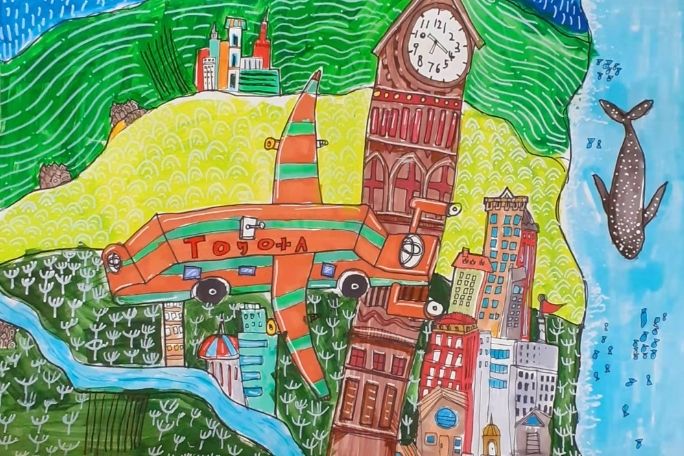Lesson summary
In this lesson, students design a dream car create an artwork to represent their ideas that will be submitted to the Toyota Dream Car Art Contest. This contest encourages and inspires creative expression and imagination in students – some amazing ideas are born from dreams! Students read The Lorax by Dr Seuss, and analyse the text, imagery, and message, focusing on how the Lorax was trying to protect his local environment. Students then identify some of the environmental features of their local area and write a short story about how they could help to look after these features with the use of a dream car. Students then illustrate their dream car, identifying the visual representations used in The Lorax and incorporating these into their own illustrations.
Learning intentions:
Students will...
- understand how messages about our world can be conveyed through stories
- understand how imagery can be used in texts to convey a mood
- understand how to communicate a message through art
- can develop and practice art-making techniques
Success criteria:
Students can...
- analyse a text to draw out its underlying message
- plan and write a short story
- plan and create artworks
- use different drawing/painting techniques
- engage in group and class discussions
Lesson guides and printables
Curriculum links
Select your curriculum from the options below.
Lesson details
Curriculum mapping
Australian curriculum content descriptions:
Year 3 English:
- Draw connections between personal experiences and the worlds of texts, and share responses with others (ACELT1596)
- Create imaginative texts based on characters, settings and events from students’ own and other cultures using visual features, for example perspective, distance and angle (ACELT1601)
- Create texts that adapt language features and patterns encountered in literary texts, for example characterisation, rhyme, rhythm, mood, music, sound effects and dialogue (ACELT1791)
Year 4 English:
- Discuss literary experiences with others, sharing responses and expressing a point of view (ACELT1603)
- Create literary texts that explore students’ own experiences and imagining (ACELT1607)
- Create literary texts by developing storylines, characters and settings (ACELT1794)
Year 4 HASS:
- The use and management of natural resources and waste, and the different views on how to do this sustainably (ACHASSK090)
Years 3 & 4 Visual Arts:
- Explore ideas and artworks from different cultures and times, including artwork by Aboriginal and Torres Strait Islander artists, to use as inspiration for their own representations (ACAVAM110)
- Use materials, techniques and processes to explore visual conventions when making artworks (ACAVAM111)
Syllabus outcomes: EN2-11D, EN2-2A, EN2-10C, GE2-2, GE2-3, VAS2.1, VAS2.2.
General capabilities: Critical and creative thinking, Literacy.
Cross-curriculum priority: Sustainability OI.7, OI.9.
Relevant parts of Year 3 English achievement standards: Students select information, ideas and events in texts that relate to their own lives and to other texts. Students create a range of texts and their texts include writing and images to express and develop, in some detail, experiences, events, information, ideas and characters.
Relevant parts of Year 4 English achievement standards: Students create texts that show understanding of how images and detail can be used to extend key ideas.
Relevant parts of Year 4 HASS achievement standards: Students identify the interconnections between components of the environment and between people and the environment.
Relevant parts of Year 3 and 4 Visual Arts achievement standards: Students describe and discuss similarities and differences between artworks they make, present and view. They discuss how they and others use visual conventions in artworks. Students plan and make artworks that are inspired by artworks they experience. They use visual conventions, techniques and processes to communicate their ideas.
Unit of work: Toyota Dream Car Contest.
Time required: 120 mins.
Level of teacher scaffolding: Medium – facilitate class discussion and guide students through the creation of artworks.
Resources required
- Paper measuring no larger than 400mm x 550 mm (15.7-21.7in.) or A3 in size
- Scrap paper for drafting
- Drawing materials, including but not limited to: coloured pencils, pens/markers, crayons, paints, watercolour paints, etc
- Student Worksheets – one copy per student
- A device capable of presenting a video to the class
- As many copies of The Lorax by Dr Seuss as you can find (up to one copy for each pair of students)
- Previous contest winners
Skills
This lesson is designed to build students’ competencies in the following skills:
- Collaboration
- Communication
- Creativity
- Critical thinking
- Problem solving
Additional info
The Toyota Dream Car Art Contest usually commences late October to early November and concludes late to early March. Find up-to-date entry details, prizes and full terms and conditions here.


Welcome back!
Don't have an account yet?
Log in with:
Create your free Cool.org account.
Many of our resources are free, with an option to upgrade to Cool+ for premium content.
Already have an account?
Sign up with:
By signing up you accept Cool.org's Terms and Conditions(Opens in new tab) and Privacy Policy(Opens in new tab).